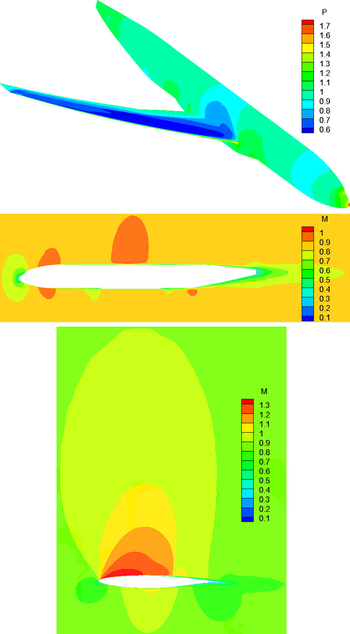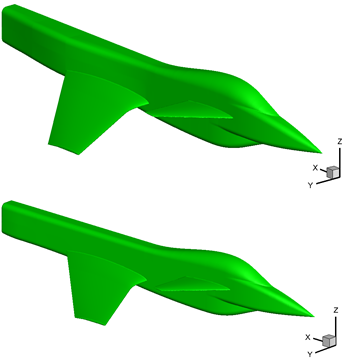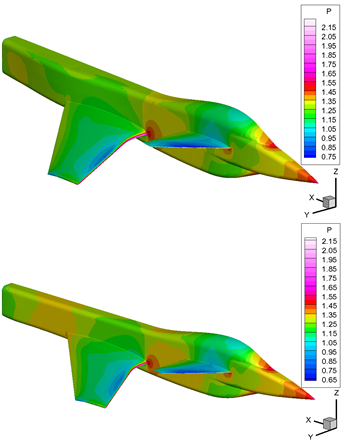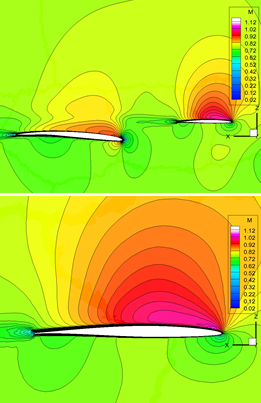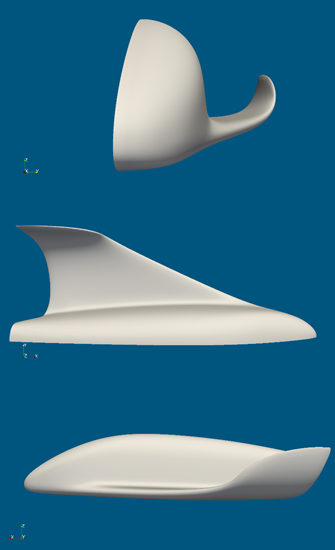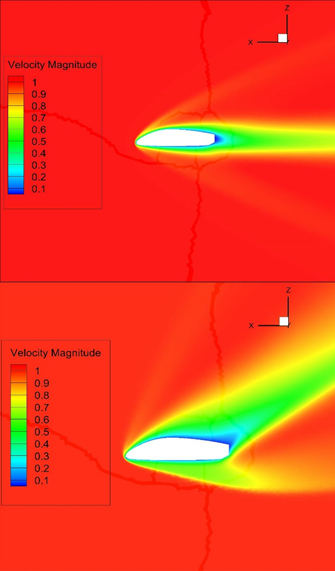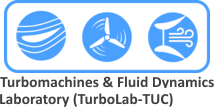Galatea is a parallelized Computational Flow Dynamics (CFD) solver for the numerical simulation of 3D compressible viscous flows in hybrid unstructured grids, developed in Fortran by members of the Turbomachines & Fluid Dynamics Laboratory (TurboLab-TUC). The flow governing equations are the non-dimensional Reynolds-Averaged Navier-Stokes (RANS) ones in 3 dimensions. For turbulence modeling and subsequently computation of the values of turbulent dynamic viscosity and turbulent kinetic energy, three two-equation models (k–ε, k–ω, and SST) have been incorporated. The interaction between flow and turbulence model equations is achieved mainly via the turbulent dynamic viscosity. Wall boundary conditions are based on the low Reynolds approach, except for k–ε model in which wall functions are used instead.
A node-centered Finite-Volume (FV) method is implemented for the discretization of the computational field in 3D hybrid unstructured grids; the median-dual control volume of a node is constructed by connecting lines defined by edge midpoints, barycenters of faces, and barycenters of elements, sharing this node. For the calculation of the convective fluxes, the Roe or the HLLC (Harten-Lax-van Leer-Contact) approximate Riemann solvers are implemented against a corresponding one-dimensional problem in the direction of the normal vector of each internal face of the control cell of a node. An edge-based data structure is employed to reduce the required computational effort and memory storage. In addition, a second-order accurate spatial scheme, based on the MUSCL (Monotone Upwind Scheme for Conservation Laws) method, is applied to increase the accuracy of the final steady-state solution. Furthermore, a slope limiter (Van Leer–Van Albada, Min-mod, Barth–Jespersen, MLP-Venkatakrishnan) supports this second-order scheme to control the total variation of the reconstructed field.
As far as the diffusive fluxes are concerned, the gradients of the velocity components and temperature have to be computed at the middle of each edge of the grid; for this calculation, two alternative methods have been incorporated in Galatea, an element-based and a nodal-averaging one. The PDEs are iteratively approximated by employing either an explicit scheme with a four-stage Runge–Kutta method or a point implicit one with the Jacobi or the Gauss–Seidel algorithm. The parallelization strategy in Galatea solver is based on the domain decomposition approach along with the message passing interface (MPI) communication protocol.
Galatea includes a parallel agglomeration multigrid method, based on the solution of the flow problem on successively coarser grids, derived from the initial finest one through the fusion of the adjacent control volumes. The agglomeration of the neighboring control cells is performed on a topology-preserving framework resembling the advancing front technique, limited though by predefined rules concerning the boundary nodes and the ghost nodes. Depending on the type of the examined flow (inviscid or viscous) and consequently on the type of the initial finest grid (tetrahedral or hybrid) either an isotropic agglomeration or a directional (semi- or full-coarsening) one can be performed.
The h-refinement method has been also incorporated in Galatea, adding more Degrees-Of-Freedom (DOF) to the examined grid in regions where high flow gradients are observed. In that way increased accuracy at user- or automatically-defined areas is obtained and significant computational savings can be achieved, as the generation of a new mesh from scratch is avoided.
In order to allow for the simulation of rarefied gas flows, slip velocity and temperature jump boundary conditions have been incorporated; improved accuracy at the solid wall surfaces is obtained with the second-order slip scheme of Beskok and Karniadakis. The normalization scheme of Ferras et al. was adopted to alleviate any excessive residual oscillations, which are derived from the Dirichlet-type of the slip/jump boundary conditions, especially during the initial steps of an explicit iterative solution procedure.
[Galatea was a Nereid who was loved by the Cyclops Polyphemus (in Greek mythology). Nereids (sea Nymphs of Greek mythology) were the daughters of the sea god Nereus and of Doris, daughter of Oceanus].
References:
G. N. Lygidakis, I.K. Nikolos, "An unstructured node-centered finite volume method for computing 3D viscous compressible flows on hybrid grids", Proceedings of the 7th GRACM International Congress on Computational Mechanics, Athens, June 30 - July 2, 2011.
G.N. Lygidakis, I.K. Nikolos, "Evaluating a parallel node-centered finite-volume algorithm, named Galatea, in simulation of 3D compressible flows", Proceedings of the 10th HSTAM International Congress on Mechanics, Chania, Crete, Greece, 25-27 May, 2013.
G.N. Lygidakis, I.K. Nikolos, "A parallel agglomeration multigrid method for the acceleration of compressible flow computation on 3D hybrid unstructured grids", Proceedings of the WCCM-ECCM-ECFD 2014 ECCOMAS Congress, Barcelona, Spain, 20-25 July, 2014.
G.N. Lygidakis, I.K. Nikolos, "Assessment of the academic CFD code "GALATEA" using the NASA Common Research Model (CRM)", Proceedings of the 12th Biennial Conference on Engineering Systems Design and Analysis ESDA 2014, June 25-29, Copenhagen, Denmark, 2014, Paper No. ESDA2014-20265. https://doi.org/10.1115/ESDA2014-20265
G.N. Lygidakis, I.K. Nikolos, "Using the DLR-F6 aircraft model for the evaluation of the academic CFD code "Galatea"", Proceedings of the ASME 2014 International Mechanical Engineering Conference & Exposition, IMECE2014, Nov. 14-20, Montreal, Quebec, Canada, Paper No. IMECE2014-39756. https://doi.org/10.1115/IMECE2014-39756
G.N. Lygidakis, I.K. Nikolos, "Numerical Analysis of Flow Over the NASA Common Research Model Using the Academic Computational Fluid Dynamics Code Galatea", ASME Journal of Fluids Engineering, Vol. 137(7), pp. 071103 - 1 - 18, 2015. https://doi.org/10.1115/1.4029730
G.N. Lygidakis, On the numerical solution of compressible flow and radiative heat transfer problems, Ph.D. Thesis, School of Production Engineering & Management, Technical University of Crete, 10/3/2015.
A.G. Klothakis, G.N. Lygidakis, I.K. Nikolos, "Numerical analysis of rarefied gas flows using the academic CFD code Galatea", in M. Papadrakakis, V. Papadopoulos, G. Stefanou, V. Plevris (Eds.), Proceedings of the ECCOMAS Congress 2016, VII European Congress on Computational Methods in Applied Science and Engineering, Crete Island, Greece, 5-10 June, 2016. DOI: 10.7712/100016.1863.5044
A.G. Klothakis, G.N. Lygidakis, I.K. Nikolos, "Rarefied gas flow analysis of a suborbital shuttle with the academic CFD code Galatea", Proceedings of the ASME International Mechanical Engineering Congress and Exposition, IMECE 2017, 3-9 November, 2017, Tampa, Florida, USA, Paper No. IMECE2017-70207. https://doi.org/10.1115/IMECE2017-70207
D.A. Inglezakis, G.N. Lygidakis, I.K. Nikolos, "Numerical flow simulation over the M151 combat aircraft model using Galatea solver", Proceedings of the 9th GRACM International Congress on Computational Mechanics, Chania, 4-6 June, 2018.
Numerical Applications and Simulations
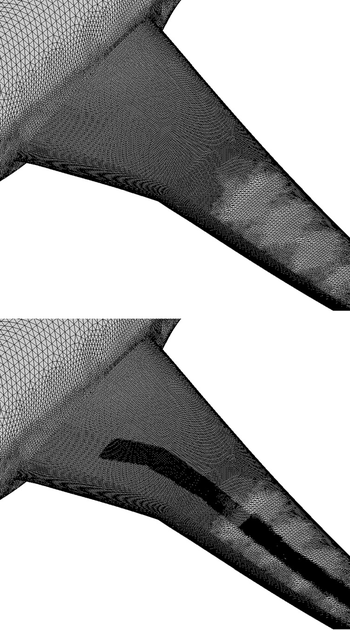
(bottom) h-refinement.
